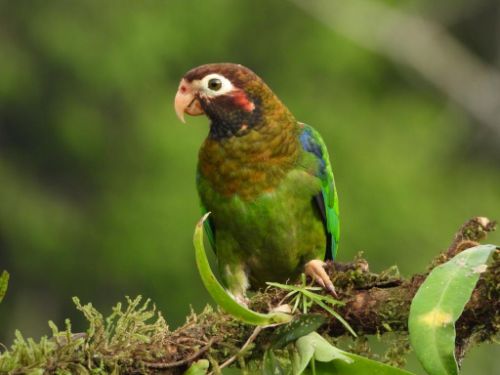The Brown-Hooded Parrot
The Brown-Hooded Parrot (Pyrilia haematotis) is a medium-sized parrot known for its distinctive brown head and bright green plumage. Native to Central America, this species is particularly common in lowland forests and foothills. Its range spans several countries, but Costa Rica offers prime habitats for this bird, making it a sought-after species for birdwatchers.

Pyrilia haematotis
Scientific Name
Psittacidae
Family
Psittaciformes
Order
P. h. haematotis
Subspecies. Found from southeastern Mexico to Panama
P. h. coccinicollaris
Subspecies. Located in eastern Panama and northwestern Colombia.
Range and Habitat
Geographic Range
Found from southern Mexico through Central America, including countries like Honduras, Nicaragua, Costa Rica, and Panama. It can also be spotted in some northern regions of South America.
Prefers humid lowland forests, and thrives at elevations of up to 1,600 meters (5,250 feet), although it is more commonly seen in lower regions.Migratory Patterns
Generally non-migratory, but may move seasonally to lower elevations in certain regions like Costa Rica.
Preferred Habitat
Humid tropical forests, including primary rainforest, cloud forests, and edges of secondary growth
Altitude Range
Prefers humid lowland forests, and thrives at elevations of up to 1,600 meters (5,250 feet), although it is more commonly seen in lower regions.
Costa Rica Habitat
In Costa Rica, the Brown-Hooded Parrot is commonly found in the Caribbean lowlands and foothills, as well as in the southern Pacific region. It favors secondary growth forests, forest edges, and sometimes agricultural areas.
Key locations to spot them in Costa Rica include Tortuguero National Park, La Selva Biological Station, and the Osa Peninsula.The bird’s preference for wet forests and lowland humid environments makes the Talamanca Mountains and Cahuita National Park important habitats within the country. Though it can tolerate some habitat disturbance, its numbers are higher in well-preserved forest regions.
Conservation Status
Least Concern
Conservation Status
Population Status
With 50,000, Brown-Hooded Parrot is currently listed as Least Concern due to its wide range and stable population numbers.
Habitat destruction due to logging and agricultural expansion.
Conservation efforts
Listed under CITES Appendix II, indicating some international trade restrictions.
Primary Threats
Habitat destruction due to logging and agricultural expansion.
Identification
The Brown-Hooded Parrot
Rarity Level:
CommonBest Viewing Times:
Early Morning (Dawn - 8 AM)
Size
21–23 cm (8.3–9.1 in) long, weighing around 145–165 g (5.1–5.3 oz).
Plumage
The head is brown, a characteristic feature that gives the bird its name. The body is predominantly green with a light blue tinge on the chest and lower body. It has a red patch on the shoulder and bright orange underwing coverts visible in flight. The tail is green with blue edging, and the beak is pale, often whitish.
Distinctive Features
Distinct red ear-patch (sometimes not easily visible unless up close), light pink legs, and a short tail.
Sexual Dimorphism
Males generally have darker facial markings.
Diet and Feeding Behavior
Primary Diet
- Their diet primarily consists of fruits, seeds, and flowers. They are known to feed on figs, palm fruits, and wild guavas. Occasionally, they will forage in agricultural areas for crops such as maize.
Foraging Techniques
- Feeds in the canopy and forest edges, often in small groups. Known for being quiet and slow-moving while foraging
Feeding Times
- Active throughout the day, feeding in pairs or small flocks
Behavior Patterns
The Brown-Hooded Parrot
Lorem ipsum dolor sit amet, consectetur adipiscing elit, sed do eiusmod tempor incididunt ut labore et dolore magna aliqua.
Social Structure
The Brown-Hooded Parrot is typically seen in pairs or small flocks of up to 10-15 individuals. They are often quiet and elusive, making them hard to spot despite their bright plumage
Song and Vocalization
While usually silent in flight, they produce a variety of high-pitched, sharp calls when foraging or perched. Their calls are described as a sharp “kee, kee” or “chik-chik.”
Courtship and Mating Ritual
Not well documented, but nests are typically made in tree cavities
Territoriality
Not aggressive, tends to avoid conflict, often silent and secretive while foraging
Birdwatching Tips
Best Locations
Some of the best spots to observe these parrots in Costa Rica include:
- Tortuguero National Park: Famous for its dense lowland forests and wetland ecosystems.
- La Selva Biological Station: A research station in the Caribbean lowlands that offers rich birdwatching opportunities.
- Carara National Park: On the Pacific side, this park hosts a range of tropical species, including the Brown-Hooded Parrot, particularly in secondary forests.
- Osa Peninsula: Home to Corcovado National Park, where parrots are often seen among a vast diversity of wildlife.

Best Time of the Year
Brown-Hooded Parrots are more active in the early morning and late afternoon, especially during their breeding season from March to June.
Common Behavior
Listening: Learning their distinct calls can greatly improve your chances of spotting them, as they often blend into the green canopy.
Recommended Gear
Bring binoculars with a good magnification (8x or 10x), as these parrots can be seen high in the canopy. A camera with a zoom lens is also recommended.
Breeding and Nesting Behavior
Breeding Season
In Costa Rica, the breeding season typically begins in March and can extend into June.
Nesting Sites
Brown-Hooded Parrots nest in tree cavities, often those made by woodpeckers or in natural hollows of large trees. They may also use artificial nest boxes if available.
Clutch Size
The typical clutch contains 3-4 eggs.
Incubation Period
{acf_breeding_and_nesting_incubation_period}
Parental Care
Did You Know?
The Brown-Hooded Parrot is sometimes confused with other small green parrots, such as the White-crowned Parrot (Pionus senilis) or Red-lored Parrot Amazona autumnalis, but its distinct brown hood and red ear-patches make identification easier.
They are less noisy than other parrots, which makes them more challenging to detect in the wild.
Costa Rica’s commitment to preserving tropical lowland forests plays a vital role in the conservation of this species, ensuring its habitat remains intact for future generations of birdwatchers.
